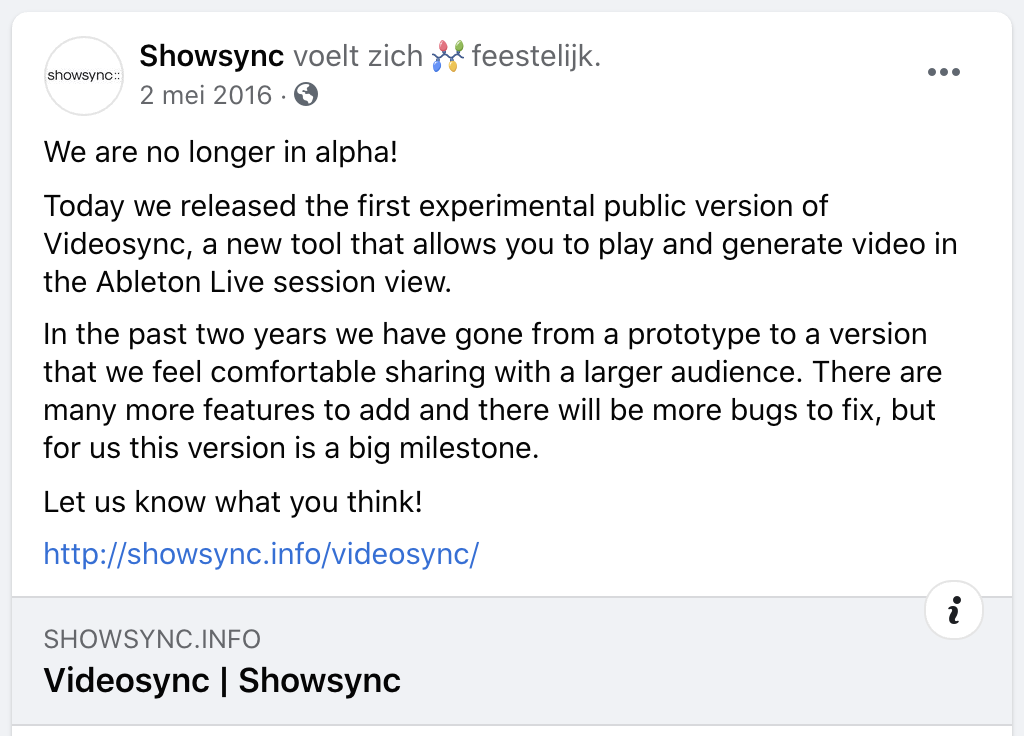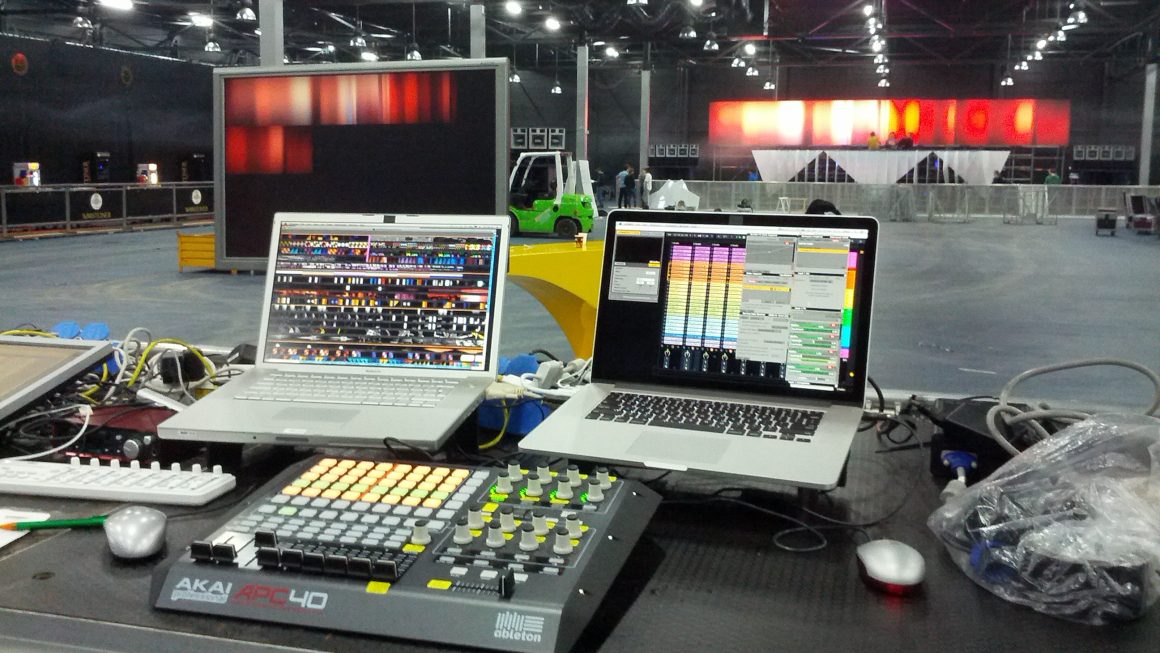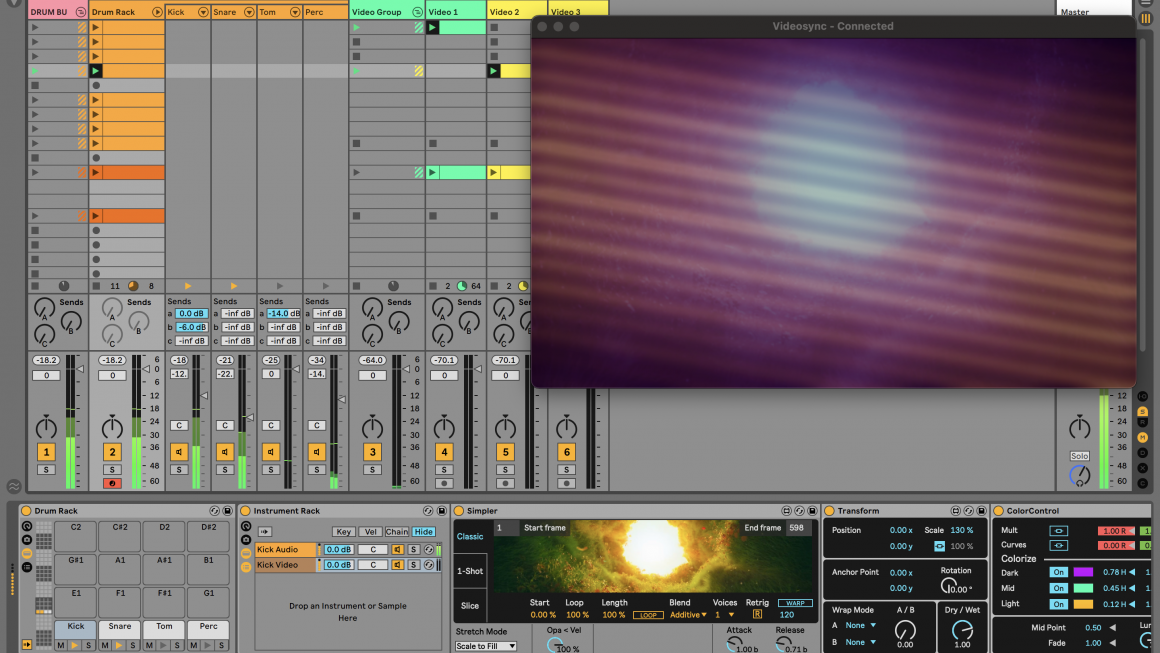We have come a long way! The release of Videosync in 2016 may have been when you first heard about Showsync, when we could finally introduce the world of AV to two new concepts that we developed: warped video playback in the Ableton Live Session view and a standalone visual signal flow that follows the Live plugin chain. Or just in 2020, with the first release of Beam, when we introduced the first system for composing lighting shows from the Live interface that scales over any fixture configuration.
But before these milestones there were all kinds of events that eventually lead to the software you can download today. Have a look at some snapshots below, that range from the earliest audiovisual experiences of the founders until the release of Videosync 1.0.
- 1998 – 2005: Mattijs studies Electrical Engineering at TU Delft and switches to Media Technology at HU. His side projects include developing audio plugins for Buzz tracker, a GPU-accelerated VJ system together with Zephod and a live performance instrument for Reaktor.
- 2005 – 2008: Mattijs works as a freelancer on interactive AV projects for various artists and brands.
- Sept 2009: Mattijs develops and releases the audiovisual tracker OSCseq (now discontinued). He concludes that creating an intuitive GUI for music is far from trivial. He experiments with Ableton Live as an interface to control multiple media.
- Oct 2009: A request comes in to trigger clips in Arkaos Media Server with MIDI notes from the Live Session view, from the Dutch urban rap group Flinke Namen in cooperation with DeepRed. Since Mattijs had been testing the first Max for Live betas, he instead prototypes a tool that plays video clips from the Session view directly.
- Dec 2009: the first version of Videosync is born. Until then, musical video tools rely on triggering video with notes and maintain a separate effects stack. But the philosophy of Videosync is significantly different: it is developed for the sole purpose of Live integration: warped video can be played with the existing Session View clip system and the visual signal flow follows the existing plugin chain in Live.
- 2010: Videosync does its first tour:
- Oct 2010: The first versions of the LiveGrabber plugins are released to use the Ableton Live interface to musically control other software, visual or otherwise.
- Feb 2011: The successful Flinke Namen tour leads to a new tour for Mason:
Lights are controlled by mapping video to lighting intensities:
- 9 Dec 2011: To synchronize lights to arbitrary incoming music, Mattijs develops Beattracker. One of the first tests to control lighting directly from Ableton Live is at a release party of Comport Records:
- 21 July 2011: Resolume asks if a tailored version of the LiveGrabber devices could be developed. This leads to the release of the Resolume M4L devices.
- In 2011, Max for Live adds the file_path API attribute, meaning it was now possible to play back video from session view clips without the need to separately assign videos to clips. With this it becomes clear that Videosync could be a user-facing product.
- Aug 2011: Continuing to develop Videosync, in cooperation with Studio Rewind it is deployed at Feed Me’s first With Teeth tour:
- Nov 2012: The first performance takes place of the FeedMe With Teeth V2 tour, now also controlling lighting. This is the first tour of Beam (then called Lightsync). The first version of LiveSync is used to support a backup machine.
- March 2013: First test of Beattracker and Beam on a large festival, Voltt Warehouse edition (warning, very distorted sound):
- 11 April 2013: Mattijs presents Showsync at This Happened:
- 7 June 2013: The first release of Livesync.
- 3 Aug 2013: The first use of Beattracker and Beam at Dekmantel Festival:
- 31 Aug 2013: Voltt loves summer with synchronized lighting takes place:
- 17-20 Oct 2013: The first appearance of Beattracker and Beam at a Dekmantel ADE party:
- 29 Jan 2014: The Feed Me With Teeth V3 tour launches:
- Jan 2014: Start of the theatre tour Eeuwige Jeugd with Angela Groothuizen and Nico Brandsen using Videosync:
- 6 March 2014: Jaap Drupsteen and Mattijs visit Coding the Club, and get inspired to start building a generative infrastructure for Videosync, a project that gets funded by the Dutch Stimuleringsfonds in order to develop the first publicly available version of Videosync.
- April 2014: Hidde and Mattijs meet at a presentation of Videosync at the Amsterdam Conservatory and are introduced by Nico Brandsen, they continue to be in touch, leading to Hidde doing an internship at Showsync.
- 2 Aug 2014: Dekmantel Festival with Beam for sync lighting happens again:
- 30 Aug 2014: Voltt loves Summer is done with with sync video and lighting (another recording here), with visuals by Jaap Drupsteen:
- 18 Oct 2014: The first performance of Kölsch with Videosync at ADE. Here is a recording of a part of the soundcheck:
- Nov 2014: Hidde officially joins Mattijs in developing Videosync and subsequently becomes a co-founder of Showsync.
- 24 Dec 2014: The first release of LiveMTC.
- May 2015: Asko Schoenberg performs La Passione with Vidoesync with visuals by Jaap Drupsteen.
- 16-18 Jul 2015: Norway celebrates Kastellnatt with synchronized lighting using Beam and Videosync:
- Aug 2015: Kölsch performs live with Videosync at SW4.
- 14 Oct 2015: Hidde and Mattijs present Videosync at the ADE playground and hand out coupons for the first public version of Videosync at Beamlab ADE.
- 27 Nov 2015: Showsync is featured in the ADE docu Resonate:
- 10 Apr 2016: Piet-Jan Blauw links Videosync to his crazy self-developed electronic instruments:
- 2 May 2016: The first public release of Videosync, version 0.7, happens on the Showsync website (then still showsync.info).

- Jun 2016: The Heineken The Takeover interactive experience driven by Videosync and Beam is launched on the Heineken Open Your World event and will continue to travel the world in subsequent years:
- 30 jul 2016: Kölsch performs at Audio River with Videosync
- 8 sept 2016: Launch of The Rhythm Painter installation at Rijksmuseum Twente, a hall with 12 synchronized screens played from one Ableton Live set, using Videosync’s networked playback feature. The launch is celebrated by a Videosync live performance at Gogbot:
- 20 Oct 2016: Jaap Drupsteen demos Videosync at Beamlab ADE.
- Sept 2017: Videosync drives an interactive installation for Visa at the Toronto International Film Festival.
- 19 Oct 2017: The Concertgebouw Orchestra performs Peter Eötvös’ Multiversum with Videosync:
- 12 Nov 2017: Hidde and Mattijs do a Videosync workshop at Ableton Loop.
- 21 Dec 2017: The first commercial version of Videosync is released. Until now, the releases were free:
- 10 Apr 2018: Videosync 0.8 is released.
- 21 Sept 2018: Nikki Hock performs Saevio with Videosync at the Todays Art festival
- 17 Mar 2019: The first version of Beattracker is released and Hidde and Mattijs are interviewed by Darwin Grosse.
- 29 Mar 2019: The royal concertgebouw orchestra performs pieces of Louis Andriessen with visuals by Jaap Drupsteen in Videosync
- 26 April 2019: Tarik Barri and Peder Mannerfelt do a performance and Hidde and Mattijs do a keynote around Showsync at the Cycling ’74 Expo at MASS MoCA in Massachusetts.
- Jun 2019: The Feed Me With Teeth tour launches again as V4, this time in its ultimate form:
- Aug 2019: Hidde and Mattijs join the cross-organizational Max for Live team at Ableton and Cycling ’74.
- 15 Oct 2019: Cycling ’74 publishes an in-depth article about using the Videosync Plugin SDK.
- 12 Jan 2020: The public release of Beam 1.0:
- 19 Apr 2021: Videosync 1.0 is released:


